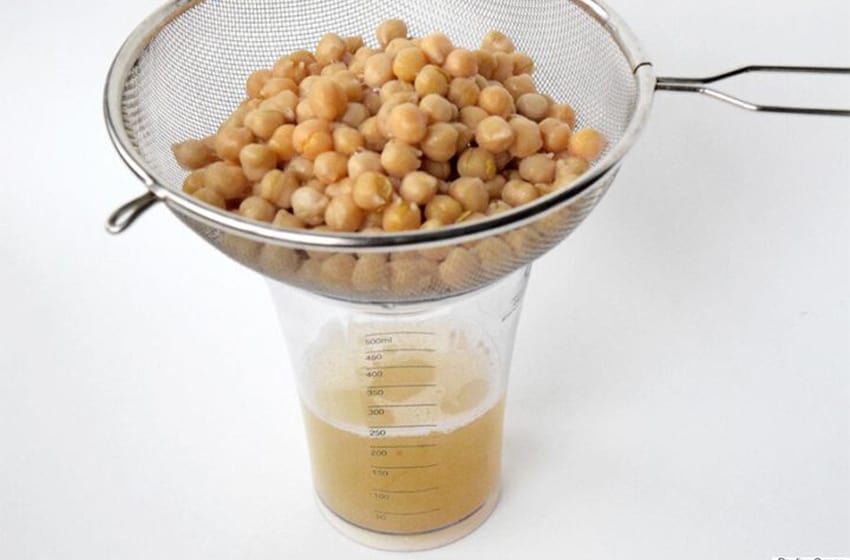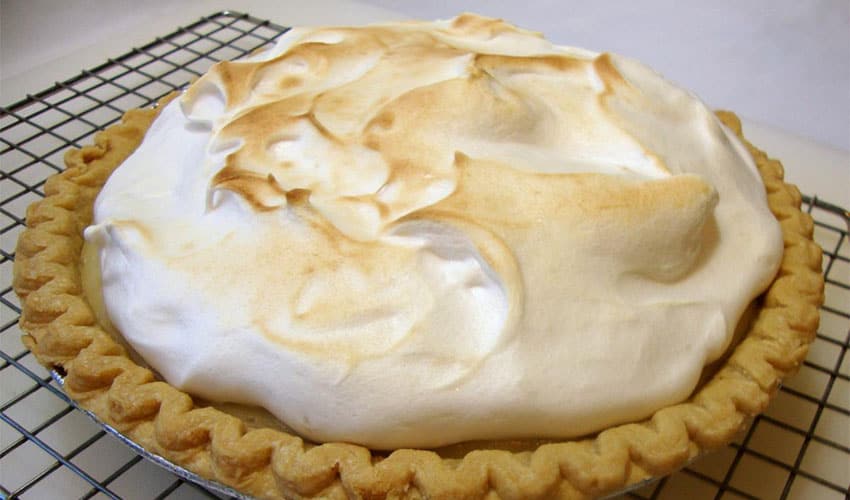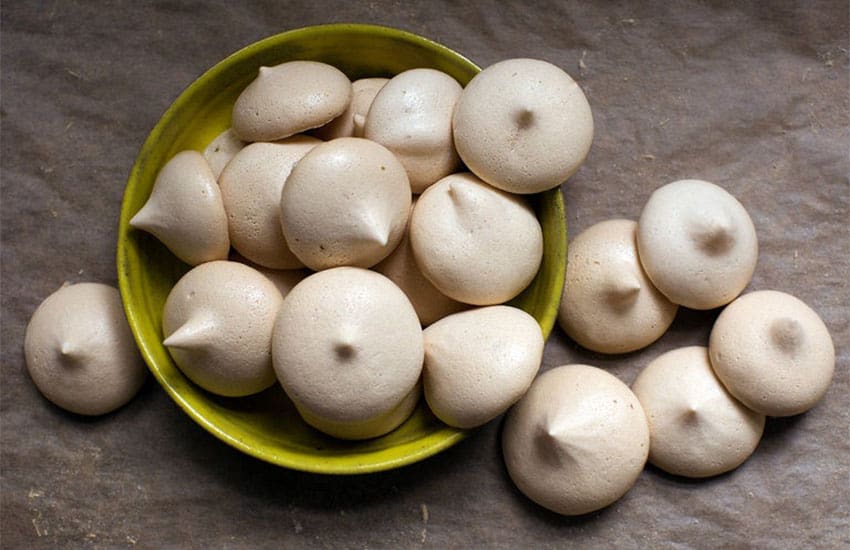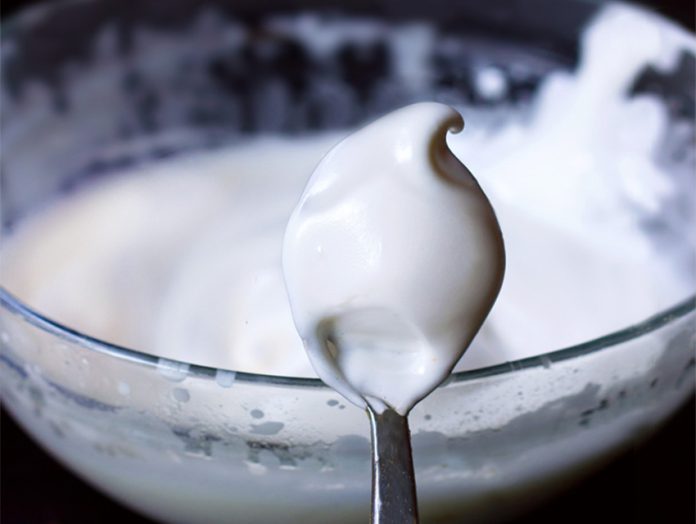I didn’t believe it either. Could not imagine how it could possibly work.
But aquafaba—the protein-packed liquid in a can of chickpeas—really does whip up like meringue, into shiny, billowing, cloud-like foam. As I’m writing this, I have a pavlova and a tray of “vegan meringue” kisses in the oven.
The scientific explanation escapes me, but it’s a simple, straightforward process to use aquafaba in place of egg whites. (It won’t work for everything, though; read on.) In the vegan world, this has been a well-kept secret that’s now been picked up by foodies—and those who can’t eat eggs—everywhere.
In my kitchen, the liquid from one 15-ounce can of chickpeas whipped up to about four cups of beautiful, white, frothy foam. Before being sweetened and flavored, there was a definite “beany” taste, but once vanilla and sugar were added, it was delicious and hard to stop taste-testing. (Ahem.)
Stiff enough to shape, I spooned some into a piping bag and made “kisses” on one cookie sheet and an 8-inch pavlova on another. Both went into a 200 F (100 C) oven for an hour while I waited excitedly for the results.
Well. Oops. Turns out my oven won’t go lower than 250F, which meant the kisses were done perfectly in an hour but the pavlova was a liquidy mess. Maybe because it was piled too deep? I re-whipped the remaining aquafaba (which worked!) and made another, thinner pavlova, this time on parchment paper. Back into the oven it went.

Aquafaba won’t work as a substitute for egg whites in every recipe; cakes, for instance—including angel food — need more structure than whipped aquafaba provides. Some cookies will work, some won’t. Mayonnaise, cocktails, froth for lattes or other coffee drinks, pie topping, mousse-like pudding? Yes indeed.
Vegan Matzo Ball Soup anyone?
It also works to make fluffier pancakes and waffles, as long as you gently and carefully fold the airy aquafaba into the batter instead of mixing it in vigorously. Also, anything you make using aquafaba needs to be cooked or baked slowly, at a low temperature, to prevent it from turning gummy or mushy.
Some other tips: look for low-sodium chickpeas (although mine were “regular” and it was fine). Some folks say you can use the liquid from any canned beans, but somehow the idea of dark brown meringue from black beans doesn’t work for me. Cannellini or white northern beans? Maybe. But why fix what isn’t broken? Garbanzos work perfectly and are easily available almost everywhere.
Can you use the water from dried chickpeas you’ve soaked or cooked? Possibly, but the ratio of water to whatever proteins make the aquafaba whip won’t be the same as in canned ones. Stick with canned chickpeas and maybe make hummus too.
Aquafaba meringue, like regular meringue, quickly absorbs humidity and gets sticky. I just popped the kisses into the toaster oven set on 200F for about 10 minutes and they crisped right up. Cream of tartar will make aquafaba beat up shinier, with stiffer peaks, but isn’t necessary.

Oh, and that pavlova? The second, thinner one baked fine. I’ll keep playing around to figure out how to make it work (or just use egg whites!)
Aquafaba Meringue
- Liquid from 1 (15 oz.) can chickpeas
- 1½-2 tsp. vanilla or almond extract
- About ¼ cup sugar
- Optional: ½ tsp. cream of tartar
Beat chickpea liquid on highest speed in bowl of a stand mixer or with a hand mixer for about 20–25 minutes until fairly stiff peaks form. (Whisking won’t work.)
Once thickened, sprinkle in sugar and vanilla, beating between each addition. If using cream of tartar, add that as well. Taste and adjust flavor and sweetness. Continue beating until stiff peaks form.
For kisses, pipe onto cookie sheet and bake at 200 F (100 C) about 1½ hours, till golden on top. Allow to cool on rack and then carefully remove with a spatula. Store in tightly closed glass container, layered with parchment, for 2–3 days.

Vegan Mayonnaise
- 1 Tbsp. apple cider vinegar
- ½-1 tsp. mustard
- ½ tsp. salt
- 3 Tbsp. liquid from a can of chickpeas (at room temperature)
- ¾-1 cup neutral oil (canola, vegetable), not olive oil
Using an immersion blender, in a small bowl combine vinegar, mustard, salt and chickpea liquid. Drizzle in oil ¼ cup at a time, beating with each addition. The mayo will thicken quickly. Transfer to a jar and store, covered, in the fridge. Yield: ¾–1 cup
Aquafaba Chocolate “Mousse”
- 1 cup aquafaba room temperature
- 2-3 Tbsp. sugar
- 1 tsp. vanilla
- 6 oz dark chocolate, melted
- Optional: 1/8 tsp. cream of tartar
Melt chocolate over boiling water or in the microwave.
In a stand mixer, combine aquafaba and cream of tartar. Whisk until soft peaks form, about 15 minutes. Add sugar and vanilla; mix until stiff peaks form. Gently fold in melted chocolate until evenly incorporated. Pour into ramekins; chill at least 4 hours.
Janet Blaser is the author of the best-selling book, Why We Left: An Anthology of American Women Expats, featured on CNBC and MarketWatch. She has lived in Mexico since 2006. You can find her on Facebook.
